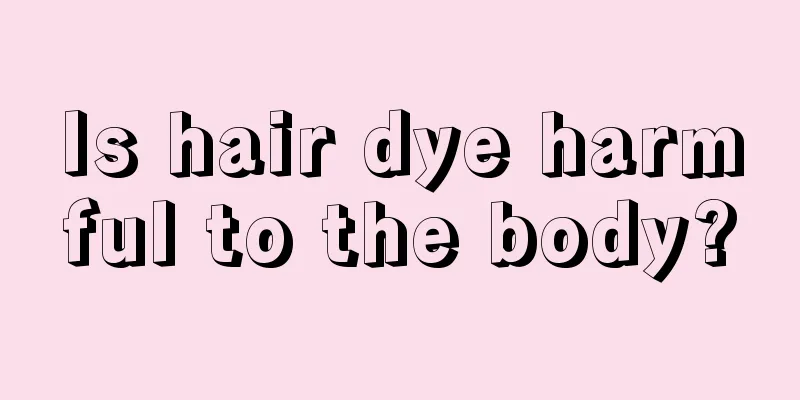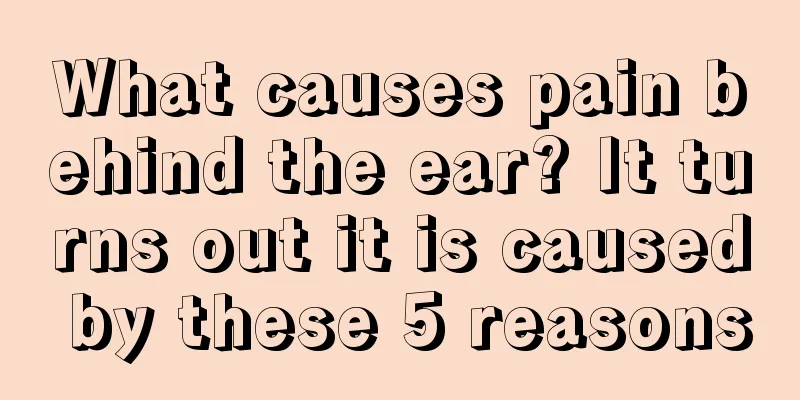Is hair dye harmful to the body?

|
Hair dyeing may seem very ordinary, but it is actually very harmful to the body. Incorrect hair dyeing for a long time and using cheap hair dyes can easily cause skin allergies. The allergies will recover in a short time, but repeated allergies over a long period of time will cause certain stimulation to the hair follicles and pores of the human body, especially the cerebral cortex, because the blockage of hair dyes causes hair follicles to atrophy, causing hair deterioration and affecting hair quality. Hair dyeing is harmful to the body, so you need to understand some knowledge about hair dyeing. The dangers of hair dyeing 1. The most common adverse reaction to hair dyeing is skin allergic reaction. Some people may not have an allergic reaction in the early stages of hair dyeing, but they may have an allergic reaction after dyeing their hair several times. The longer it is used, the higher the chance of allergy. 2. Dyeing your hair too often can lead to hair loss. The irritation to the scalp will cause inflammation of the scalp and hair follicles, which will cause the hair follicles to atrophy over time. The harm will continue to increase, and the hair will become thinner and finally fall out. 3. Hair dyeing can cause changes in people's hair quality. The dyeing process will affect the moisture imbalance in the hair and cause the denaturation and reduction of a large amount of protein. This causes hair to become brittle. Another major harm of hair dyeing is that it can cause hair fibers to break, causing them to lose their natural softness, toughness and luster. The more times you dye your hair, the more serious the damage will be. 4. Hair dyes are the most harmful. Their toxic substances can damage liver and kidney functions. They are often found in metal hair dyes and some synthetic organic hair dyes, such as hair dyes containing lead acetate and silver nitrate, and containing benzene, naphthalene, phenols, etc. Scalp hair follicles are the best channel for toxins to enter the human body. Hair dyes are harmful to the human body, but except for allergies, most of the adverse effects will not appear immediately or in a short period of time. However, this does not mean that people can take the harm of hair dyeing lightly. "In fact, the harm of hair dyeing is like smoking. Although not everyone who smokes will get lung cancer, and not every smoker will get lung cancer, no one can deny that lung cancer and cigarettes are inextricably linked." Similarly, more and more studies have proven that the harm of hair dyeing to the human body is real, but there is no clear conclusion on how these harms occur and how long they will remain dormant in the human body. Hair dye comes into contact with the human scalp, "which is where the body has the most and densest hair follicles, and these are the channels through which chemical components enter the body." Therefore, as long as the dye comes into contact with the scalp, chemical toxins can enter the human body through the countless "channels" on it. Not only that, even if the hair dye does not directly contact the scalp, the chemical components in it evaporate and the gases formed can still enter the human body through the hair follicles. For this reason, Director Yang believes that in order to avoid the harm of hair dyeing, it is best not to dye your hair. 1. The less times you dye your hair, the better. It should not exceed twice a year, and you only need to dye the newly grown parts. 2. Permanent hair dye should be used less. Consumers who use permanent black hair dye should consider switching to a lighter color because the darker the color, the more toxic it is. Generally speaking, hair dyes that fade when you wash your hair three or four days after dyeing are temporary hair dyes, hair dyes that fade one to two weeks after dyeing are semi-permanent hair dyes, and hair dyes that basically do not fade for more than two weeks after dyeing are permanent hair dyes. The first two are less toxic, while the latter is more toxic. 3. Do not dye your hair with different hair dyes at the same time. Hair dyes may react chemically to produce toxic substances. 4. It is best to keep hair dye close to 1 cm away from the scalp. 5. People with boils, skin ulcers and those who are allergic to hair dye should not dye their hair. If you insist on dyeing your hair, be sure to do an allergy test. Apply the hair dye on the skin behind the ear. If there is no abnormal reaction within two days, you can dye your hair. People with high blood pressure, heart disease, or those who are pregnant or giving birth should not dye their hair. |
<<: What is the best way to dehumidify the body
>>: What is the reason for the echo in the ears
Recommend
What is the normal value of carcinoembryonic antigen? There are several ranges
The normal value of carcinoembryonic antigen refe...
What should I do if my arachnoid cyst is serious?
Arachnoid cyst is a relatively serious disease. P...
How to use blackhead extraction liquid, how to use it, how to use it
Everyone loves beauty, and beautiful skin can mak...
How will the symptoms of liver cancer progress? Two types of moldy food are likely to induce liver cancer
The liver is the most important organ in the huma...
What to do if the non-stick pan sticks
Many families now use very convenient and practic...
Can I still use the non-stick pan if the coating falls off?
I believe that everyone uses them quite frequentl...
Where is the upper eyelid located?
The eyelids are soft tissues that grow in front o...
What is the best way to eat wolfberry?
Wolfberry has a strong health-preserving function...
Why does nasopharyngeal cancer occur? What should we pay attention to in our diet for nasopharyngeal cancer
What should be paid attention to in the diet of n...
Does black sesame paste cause internal heat?
I believe that many of you love to eat black sesa...
What department should I go to if my eyelids are twitching
Eyelid twitching is a very common symptom. If it ...
How to detect atherosclerosis?
Atherosclerosis is not unfamiliar to many people....
Which acupoints on the back can be massaged?
The human body is composed of many acupuncture po...
Where to massage the hand for constipation
There are many common diseases in life, and const...
Do you know the treatment methods for Hashimoto's thyroiditis?
Hashimoto's thyroiditis is also a type of thy...









